Unit 31 Food Safety Management Report: Ritz Hotel Food Safety Analysis
VerifiedAdded on 2020/12/29
|14
|3812
|96
Report
AI Summary
This report provides a detailed analysis of food safety management, focusing on The Ritz Hotel. It begins with an introduction to food safety principles and then delves into specific aspects such as controlling physical and chemical contamination, comparing food poisoning and foodborne infections, and discussing control measures for foodborne illnesses. The report categorizes food spoilage agents and examines various food preservation methods, evaluating their effectiveness. It explores the key steps in a Temperature Control System (TCS), safe food storage techniques, the benefits of personal hygiene, the importance of cleaning and disinfection, pest control issues, and the necessity of hygiene design in food premises. Furthermore, the report assesses food hazard risk, food safety control systems, and compliance with food safety legislation. The report concludes with an overview of the key findings and references used throughout the analysis. The report also provides valuable insights into the practical application of food safety principles within a hospitality setting.
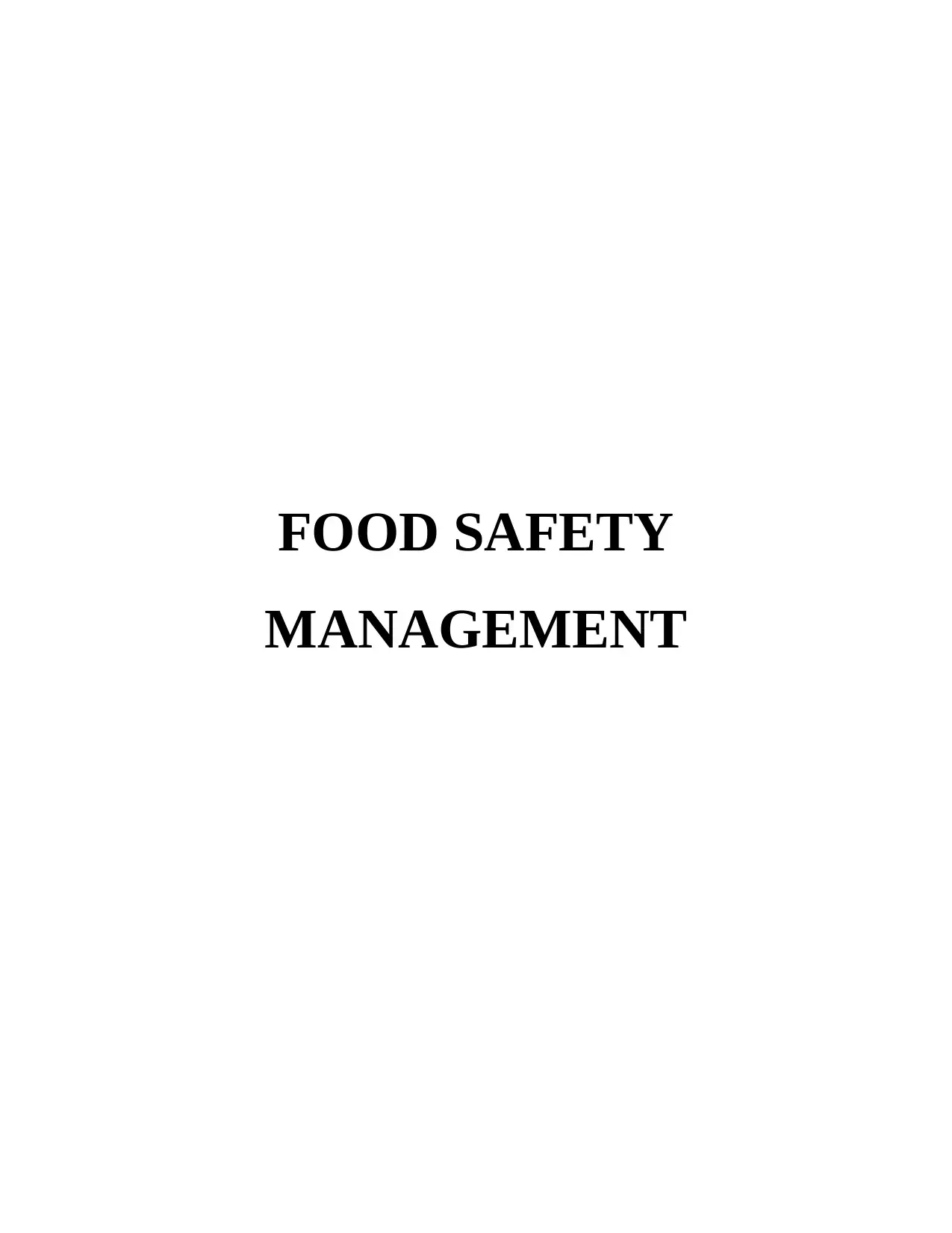
FOOD SAFETY
MANAGEMENT
MANAGEMENT
Paraphrase This Document
Need a fresh take? Get an instant paraphrase of this document with our AI Paraphraser
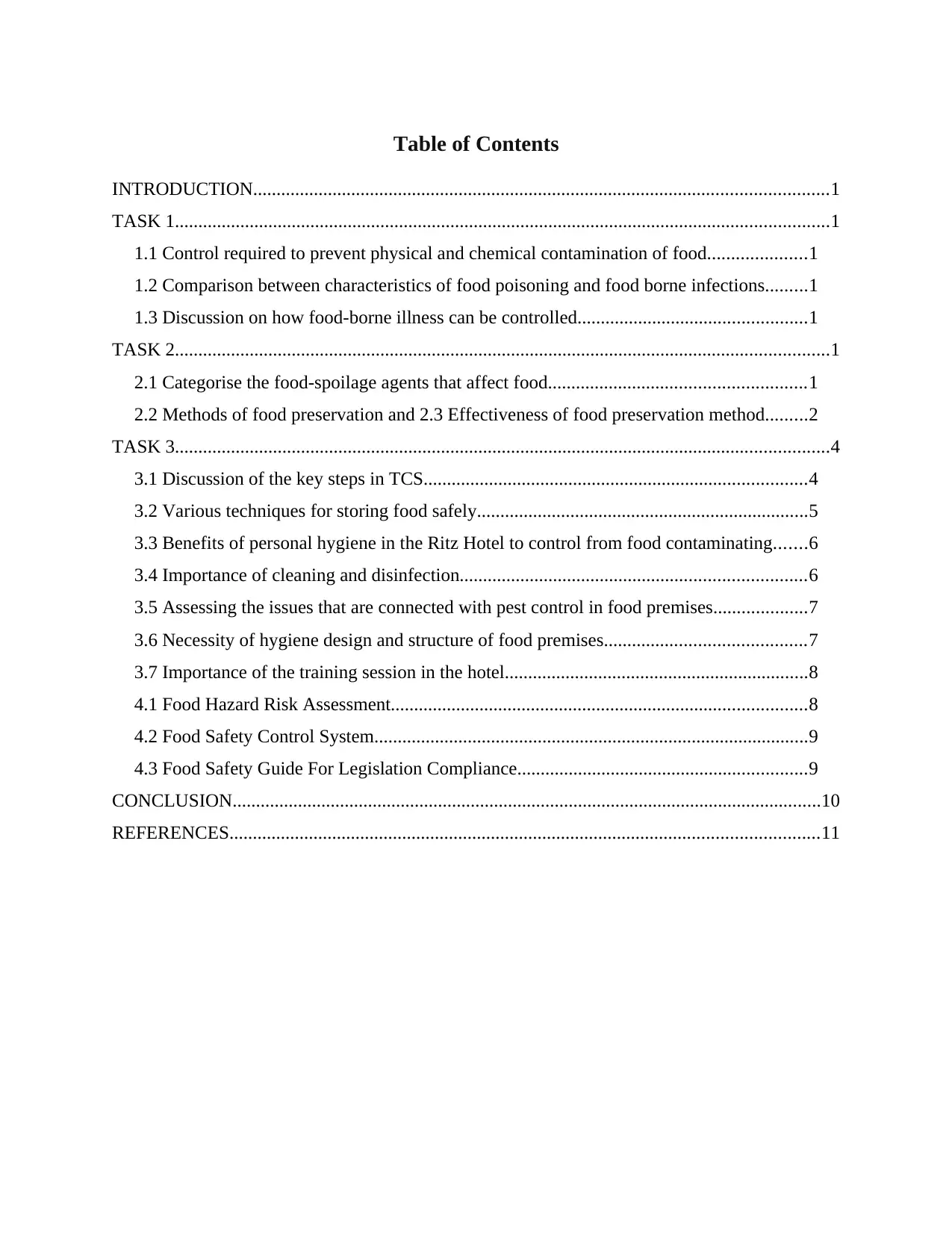
Table of Contents
INTRODUCTION...........................................................................................................................1
TASK 1............................................................................................................................................1
1.1 Control required to prevent physical and chemical contamination of food.....................1
1.2 Comparison between characteristics of food poisoning and food borne infections.........1
1.3 Discussion on how food-borne illness can be controlled.................................................1
TASK 2............................................................................................................................................1
2.1 Categorise the food-spoilage agents that affect food.......................................................1
2.2 Methods of food preservation and 2.3 Effectiveness of food preservation method.........2
TASK 3............................................................................................................................................4
3.1 Discussion of the key steps in TCS..................................................................................4
3.2 Various techniques for storing food safely.......................................................................5
3.3 Benefits of personal hygiene in the Ritz Hotel to control from food contaminating.......6
3.4 Importance of cleaning and disinfection..........................................................................6
3.5 Assessing the issues that are connected with pest control in food premises....................7
3.6 Necessity of hygiene design and structure of food premises...........................................7
3.7 Importance of the training session in the hotel.................................................................8
4.1 Food Hazard Risk Assessment.........................................................................................8
4.2 Food Safety Control System.............................................................................................9
4.3 Food Safety Guide For Legislation Compliance..............................................................9
CONCLUSION..............................................................................................................................10
REFERENCES..............................................................................................................................11
INTRODUCTION...........................................................................................................................1
TASK 1............................................................................................................................................1
1.1 Control required to prevent physical and chemical contamination of food.....................1
1.2 Comparison between characteristics of food poisoning and food borne infections.........1
1.3 Discussion on how food-borne illness can be controlled.................................................1
TASK 2............................................................................................................................................1
2.1 Categorise the food-spoilage agents that affect food.......................................................1
2.2 Methods of food preservation and 2.3 Effectiveness of food preservation method.........2
TASK 3............................................................................................................................................4
3.1 Discussion of the key steps in TCS..................................................................................4
3.2 Various techniques for storing food safely.......................................................................5
3.3 Benefits of personal hygiene in the Ritz Hotel to control from food contaminating.......6
3.4 Importance of cleaning and disinfection..........................................................................6
3.5 Assessing the issues that are connected with pest control in food premises....................7
3.6 Necessity of hygiene design and structure of food premises...........................................7
3.7 Importance of the training session in the hotel.................................................................8
4.1 Food Hazard Risk Assessment.........................................................................................8
4.2 Food Safety Control System.............................................................................................9
4.3 Food Safety Guide For Legislation Compliance..............................................................9
CONCLUSION..............................................................................................................................10
REFERENCES..............................................................................................................................11
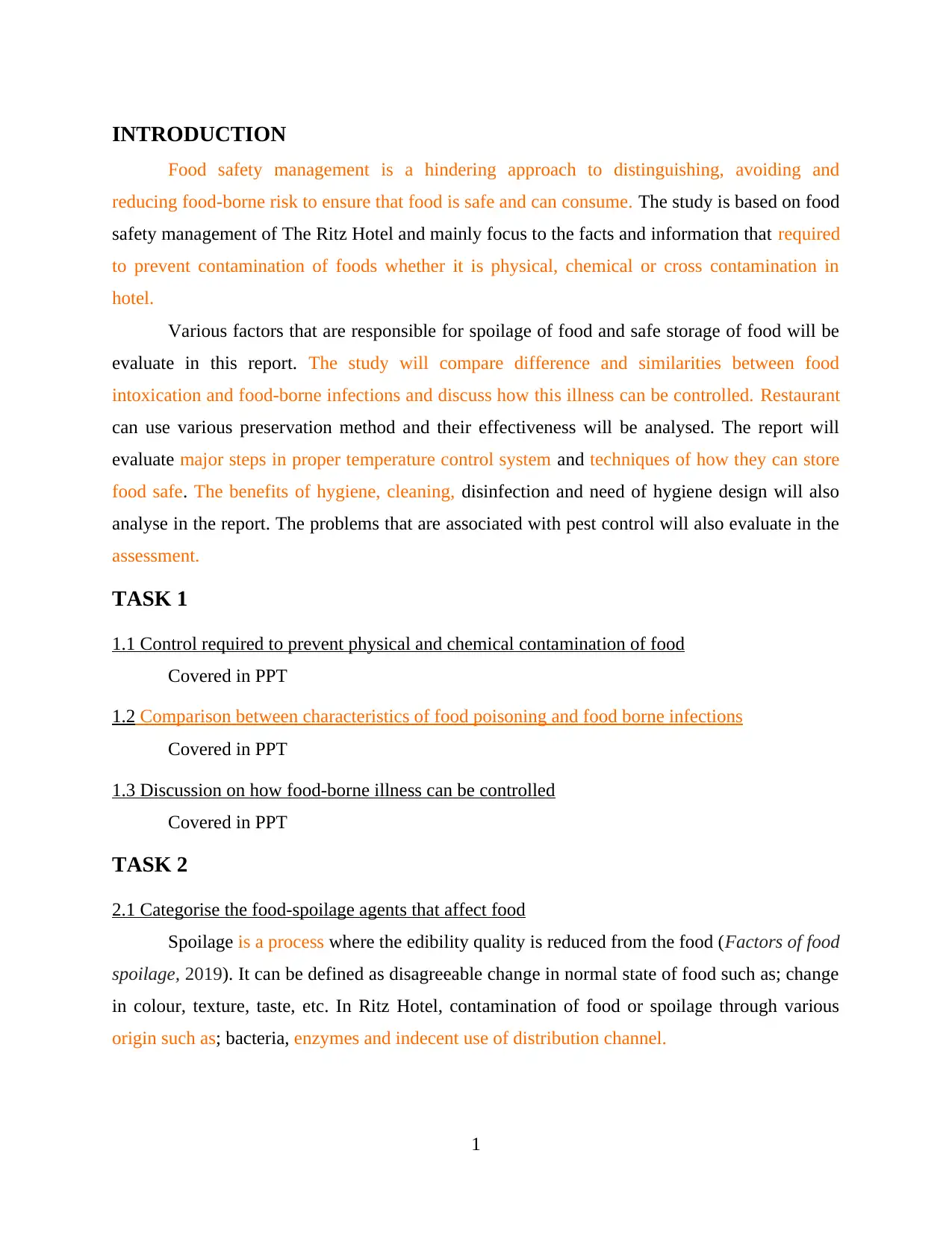
INTRODUCTION
Food safety management is a hindering approach to distinguishing, avoiding and
reducing food-borne risk to ensure that food is safe and can consume. The study is based on food
safety management of The Ritz Hotel and mainly focus to the facts and information that required
to prevent contamination of foods whether it is physical, chemical or cross contamination in
hotel.
Various factors that are responsible for spoilage of food and safe storage of food will be
evaluate in this report. The study will compare difference and similarities between food
intoxication and food-borne infections and discuss how this illness can be controlled. Restaurant
can use various preservation method and their effectiveness will be analysed. The report will
evaluate major steps in proper temperature control system and techniques of how they can store
food safe. The benefits of hygiene, cleaning, disinfection and need of hygiene design will also
analyse in the report. The problems that are associated with pest control will also evaluate in the
assessment.
TASK 1
1.1 Control required to prevent physical and chemical contamination of food
Covered in PPT
1.2 Comparison between characteristics of food poisoning and food borne infections
Covered in PPT
1.3 Discussion on how food-borne illness can be controlled
Covered in PPT
TASK 2
2.1 Categorise the food-spoilage agents that affect food
Spoilage is a process where the edibility quality is reduced from the food (Factors of food
spoilage, 2019). It can be defined as disagreeable change in normal state of food such as; change
in colour, texture, taste, etc. In Ritz Hotel, contamination of food or spoilage through various
origin such as; bacteria, enzymes and indecent use of distribution channel.
1
Food safety management is a hindering approach to distinguishing, avoiding and
reducing food-borne risk to ensure that food is safe and can consume. The study is based on food
safety management of The Ritz Hotel and mainly focus to the facts and information that required
to prevent contamination of foods whether it is physical, chemical or cross contamination in
hotel.
Various factors that are responsible for spoilage of food and safe storage of food will be
evaluate in this report. The study will compare difference and similarities between food
intoxication and food-borne infections and discuss how this illness can be controlled. Restaurant
can use various preservation method and their effectiveness will be analysed. The report will
evaluate major steps in proper temperature control system and techniques of how they can store
food safe. The benefits of hygiene, cleaning, disinfection and need of hygiene design will also
analyse in the report. The problems that are associated with pest control will also evaluate in the
assessment.
TASK 1
1.1 Control required to prevent physical and chemical contamination of food
Covered in PPT
1.2 Comparison between characteristics of food poisoning and food borne infections
Covered in PPT
1.3 Discussion on how food-borne illness can be controlled
Covered in PPT
TASK 2
2.1 Categorise the food-spoilage agents that affect food
Spoilage is a process where the edibility quality is reduced from the food (Factors of food
spoilage, 2019). It can be defined as disagreeable change in normal state of food such as; change
in colour, texture, taste, etc. In Ritz Hotel, contamination of food or spoilage through various
origin such as; bacteria, enzymes and indecent use of distribution channel.
1
⊘ This is a preview!⊘
Do you want full access?
Subscribe today to unlock all pages.

Trusted by 1+ million students worldwide
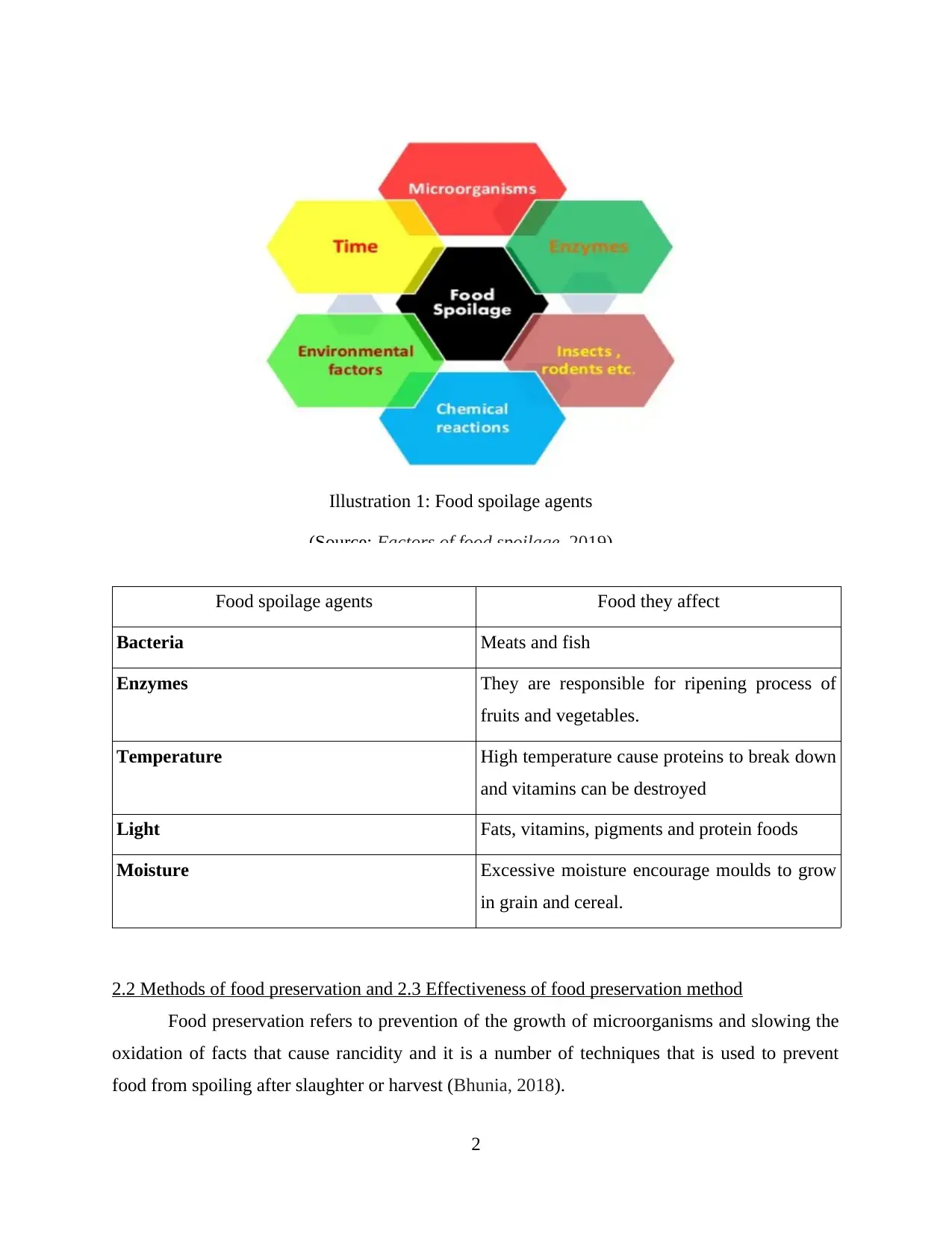
Food spoilage agents Food they affect
Bacteria Meats and fish
Enzymes They are responsible for ripening process of
fruits and vegetables.
Temperature High temperature cause proteins to break down
and vitamins can be destroyed
Light Fats, vitamins, pigments and protein foods
Moisture Excessive moisture encourage moulds to grow
in grain and cereal.
2.2 Methods of food preservation and 2.3 Effectiveness of food preservation method
Food preservation refers to prevention of the growth of microorganisms and slowing the
oxidation of facts that cause rancidity and it is a number of techniques that is used to prevent
food from spoiling after slaughter or harvest (Bhunia, 2018).
2
Illustration 1: Food spoilage agents
(Source: Factors of food spoilage, 2019)
Bacteria Meats and fish
Enzymes They are responsible for ripening process of
fruits and vegetables.
Temperature High temperature cause proteins to break down
and vitamins can be destroyed
Light Fats, vitamins, pigments and protein foods
Moisture Excessive moisture encourage moulds to grow
in grain and cereal.
2.2 Methods of food preservation and 2.3 Effectiveness of food preservation method
Food preservation refers to prevention of the growth of microorganisms and slowing the
oxidation of facts that cause rancidity and it is a number of techniques that is used to prevent
food from spoiling after slaughter or harvest (Bhunia, 2018).
2
Illustration 1: Food spoilage agents
(Source: Factors of food spoilage, 2019)
Paraphrase This Document
Need a fresh take? Get an instant paraphrase of this document with our AI Paraphraser
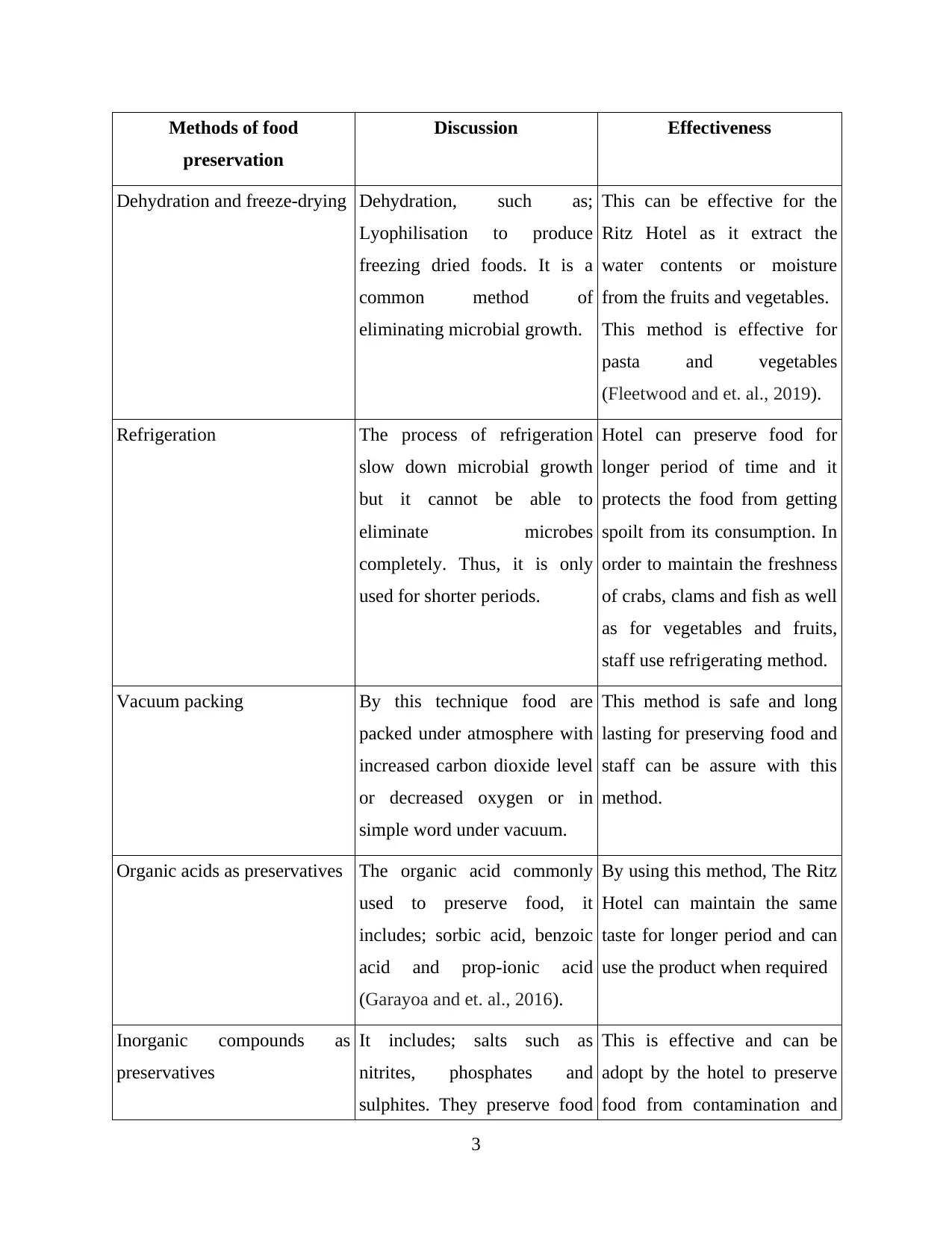
Methods of food
preservation
Discussion Effectiveness
Dehydration and freeze-drying Dehydration, such as;
Lyophilisation to produce
freezing dried foods. It is a
common method of
eliminating microbial growth.
This can be effective for the
Ritz Hotel as it extract the
water contents or moisture
from the fruits and vegetables.
This method is effective for
pasta and vegetables
(Fleetwood and et. al., 2019).
Refrigeration The process of refrigeration
slow down microbial growth
but it cannot be able to
eliminate microbes
completely. Thus, it is only
used for shorter periods.
Hotel can preserve food for
longer period of time and it
protects the food from getting
spoilt from its consumption. In
order to maintain the freshness
of crabs, clams and fish as well
as for vegetables and fruits,
staff use refrigerating method.
Vacuum packing By this technique food are
packed under atmosphere with
increased carbon dioxide level
or decreased oxygen or in
simple word under vacuum.
This method is safe and long
lasting for preserving food and
staff can be assure with this
method.
Organic acids as preservatives The organic acid commonly
used to preserve food, it
includes; sorbic acid, benzoic
acid and prop-ionic acid
(Garayoa and et. al., 2016).
By using this method, The Ritz
Hotel can maintain the same
taste for longer period and can
use the product when required
Inorganic compounds as
preservatives
It includes; salts such as
nitrites, phosphates and
sulphites. They preserve food
This is effective and can be
adopt by the hotel to preserve
food from contamination and
3
preservation
Discussion Effectiveness
Dehydration and freeze-drying Dehydration, such as;
Lyophilisation to produce
freezing dried foods. It is a
common method of
eliminating microbial growth.
This can be effective for the
Ritz Hotel as it extract the
water contents or moisture
from the fruits and vegetables.
This method is effective for
pasta and vegetables
(Fleetwood and et. al., 2019).
Refrigeration The process of refrigeration
slow down microbial growth
but it cannot be able to
eliminate microbes
completely. Thus, it is only
used for shorter periods.
Hotel can preserve food for
longer period of time and it
protects the food from getting
spoilt from its consumption. In
order to maintain the freshness
of crabs, clams and fish as well
as for vegetables and fruits,
staff use refrigerating method.
Vacuum packing By this technique food are
packed under atmosphere with
increased carbon dioxide level
or decreased oxygen or in
simple word under vacuum.
This method is safe and long
lasting for preserving food and
staff can be assure with this
method.
Organic acids as preservatives The organic acid commonly
used to preserve food, it
includes; sorbic acid, benzoic
acid and prop-ionic acid
(Garayoa and et. al., 2016).
By using this method, The Ritz
Hotel can maintain the same
taste for longer period and can
use the product when required
Inorganic compounds as
preservatives
It includes; salts such as
nitrites, phosphates and
sulphites. They preserve food
This is effective and can be
adopt by the hotel to preserve
food from contamination and
3
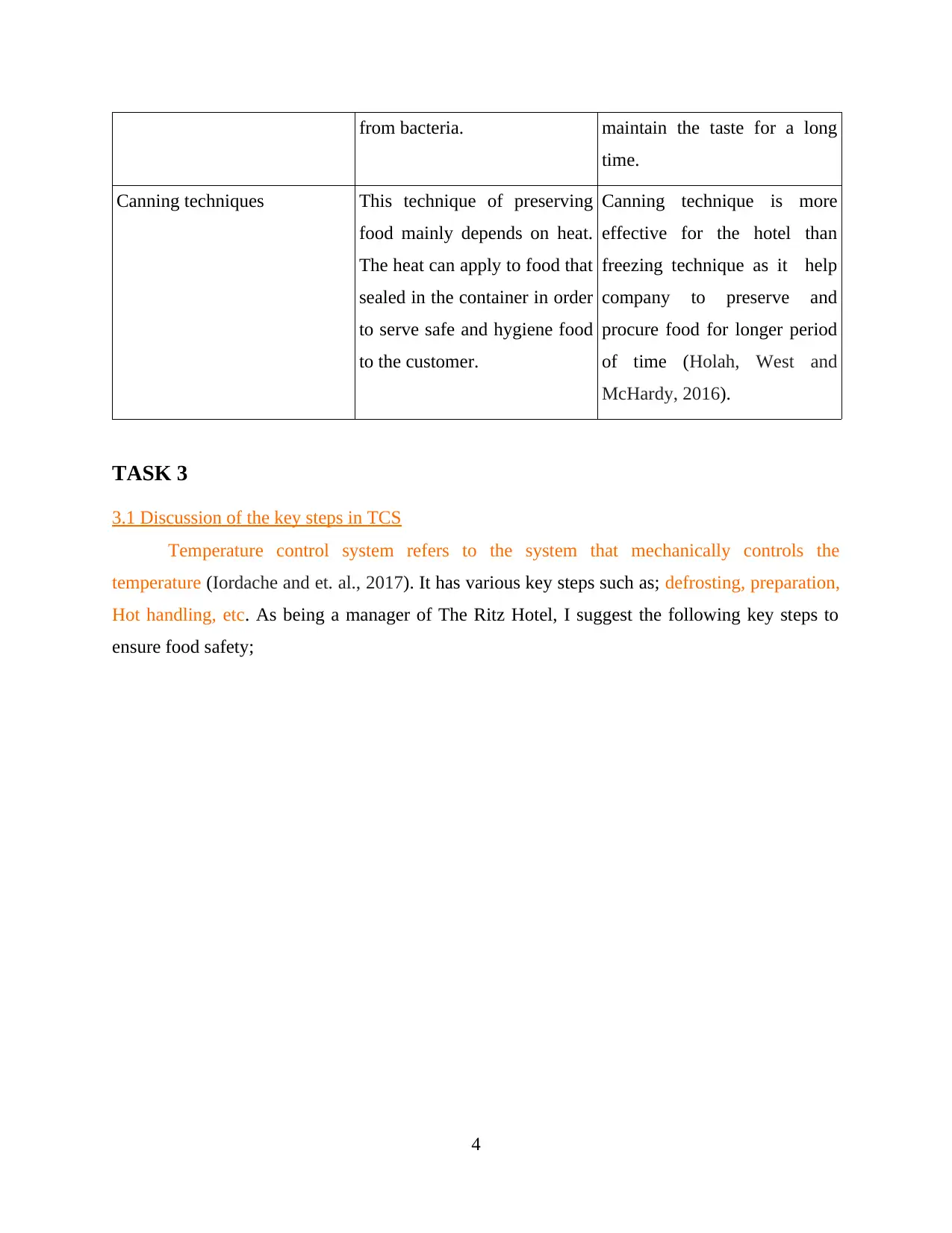
from bacteria. maintain the taste for a long
time.
Canning techniques This technique of preserving
food mainly depends on heat.
The heat can apply to food that
sealed in the container in order
to serve safe and hygiene food
to the customer.
Canning technique is more
effective for the hotel than
freezing technique as it help
company to preserve and
procure food for longer period
of time (Holah, West and
McHardy, 2016).
TASK 3
3.1 Discussion of the key steps in TCS
Temperature control system refers to the system that mechanically controls the
temperature (Iordache and et. al., 2017). It has various key steps such as; defrosting, preparation,
Hot handling, etc. As being a manager of The Ritz Hotel, I suggest the following key steps to
ensure food safety;
4
time.
Canning techniques This technique of preserving
food mainly depends on heat.
The heat can apply to food that
sealed in the container in order
to serve safe and hygiene food
to the customer.
Canning technique is more
effective for the hotel than
freezing technique as it help
company to preserve and
procure food for longer period
of time (Holah, West and
McHardy, 2016).
TASK 3
3.1 Discussion of the key steps in TCS
Temperature control system refers to the system that mechanically controls the
temperature (Iordache and et. al., 2017). It has various key steps such as; defrosting, preparation,
Hot handling, etc. As being a manager of The Ritz Hotel, I suggest the following key steps to
ensure food safety;
4
⊘ This is a preview!⊘
Do you want full access?
Subscribe today to unlock all pages.

Trusted by 1+ million students worldwide
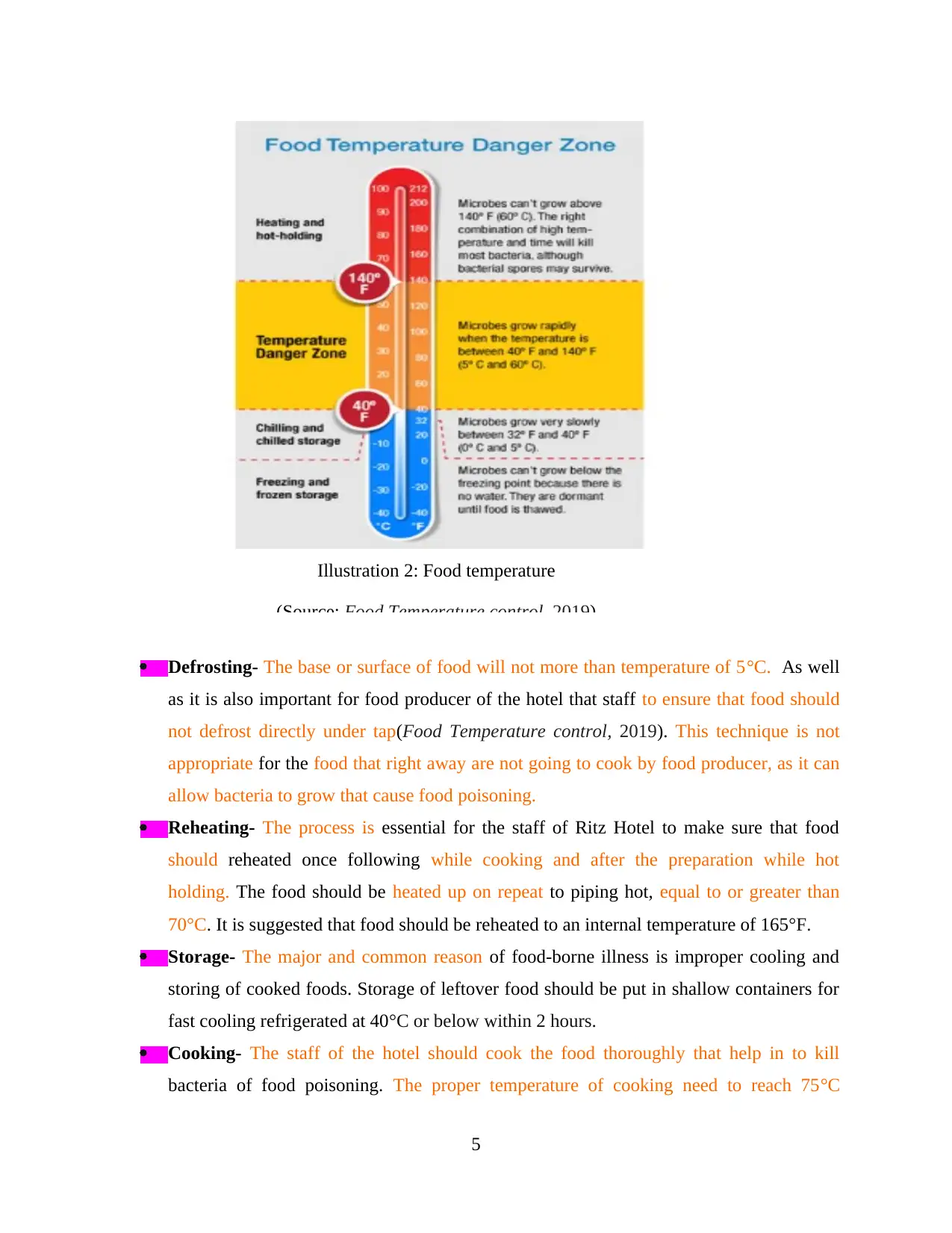
Defrosting- The base or surface of food will not more than temperature of 5°C. As well
as it is also important for food producer of the hotel that staff to ensure that food should
not defrost directly under tap(Food Temperature control, 2019). This technique is not
appropriate for the food that right away are not going to cook by food producer, as it can
allow bacteria to grow that cause food poisoning.
Reheating- The process is essential for the staff of Ritz Hotel to make sure that food
should reheated once following while cooking and after the preparation while hot
holding. The food should be heated up on repeat to piping hot, equal to or greater than
70°C. It is suggested that food should be reheated to an internal temperature of 165°F.
Storage- The major and common reason of food-borne illness is improper cooling and
storing of cooked foods. Storage of leftover food should be put in shallow containers for
fast cooling refrigerated at 40°C or below within 2 hours.
Cooking- The staff of the hotel should cook the food thoroughly that help in to kill
bacteria of food poisoning. The proper temperature of cooking need to reach 75°C
5
Illustration 2: Food temperature
(Source: Food Temperature control, 2019)
as it is also important for food producer of the hotel that staff to ensure that food should
not defrost directly under tap(Food Temperature control, 2019). This technique is not
appropriate for the food that right away are not going to cook by food producer, as it can
allow bacteria to grow that cause food poisoning.
Reheating- The process is essential for the staff of Ritz Hotel to make sure that food
should reheated once following while cooking and after the preparation while hot
holding. The food should be heated up on repeat to piping hot, equal to or greater than
70°C. It is suggested that food should be reheated to an internal temperature of 165°F.
Storage- The major and common reason of food-borne illness is improper cooling and
storing of cooked foods. Storage of leftover food should be put in shallow containers for
fast cooling refrigerated at 40°C or below within 2 hours.
Cooking- The staff of the hotel should cook the food thoroughly that help in to kill
bacteria of food poisoning. The proper temperature of cooking need to reach 75°C
5
Illustration 2: Food temperature
(Source: Food Temperature control, 2019)
Paraphrase This Document
Need a fresh take? Get an instant paraphrase of this document with our AI Paraphraser
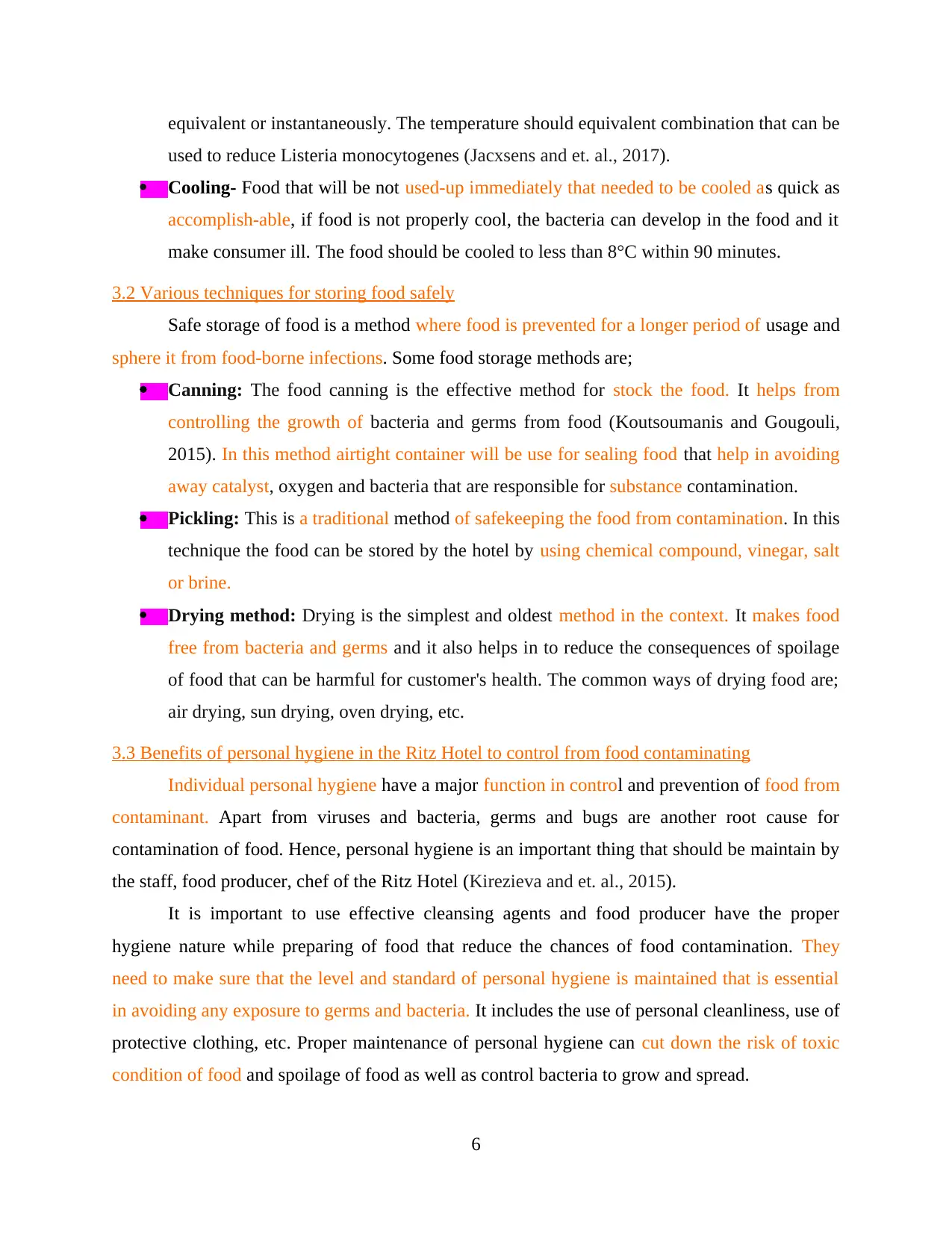
equivalent or instantaneously. The temperature should equivalent combination that can be
used to reduce Listeria monocytogenes (Jacxsens and et. al., 2017).
Cooling- Food that will be not used-up immediately that needed to be cooled as quick as
accomplish-able, if food is not properly cool, the bacteria can develop in the food and it
make consumer ill. The food should be cooled to less than 8°C within 90 minutes.
3.2 Various techniques for storing food safely
Safe storage of food is a method where food is prevented for a longer period of usage and
sphere it from food-borne infections. Some food storage methods are;
Canning: The food canning is the effective method for stock the food. It helps from
controlling the growth of bacteria and germs from food (Koutsoumanis and Gougouli,
2015). In this method airtight container will be use for sealing food that help in avoiding
away catalyst, oxygen and bacteria that are responsible for substance contamination.
Pickling: This is a traditional method of safekeeping the food from contamination. In this
technique the food can be stored by the hotel by using chemical compound, vinegar, salt
or brine.
Drying method: Drying is the simplest and oldest method in the context. It makes food
free from bacteria and germs and it also helps in to reduce the consequences of spoilage
of food that can be harmful for customer's health. The common ways of drying food are;
air drying, sun drying, oven drying, etc.
3.3 Benefits of personal hygiene in the Ritz Hotel to control from food contaminating
Individual personal hygiene have a major function in control and prevention of food from
contaminant. Apart from viruses and bacteria, germs and bugs are another root cause for
contamination of food. Hence, personal hygiene is an important thing that should be maintain by
the staff, food producer, chef of the Ritz Hotel (Kirezieva and et. al., 2015).
It is important to use effective cleansing agents and food producer have the proper
hygiene nature while preparing of food that reduce the chances of food contamination. They
need to make sure that the level and standard of personal hygiene is maintained that is essential
in avoiding any exposure to germs and bacteria. It includes the use of personal cleanliness, use of
protective clothing, etc. Proper maintenance of personal hygiene can cut down the risk of toxic
condition of food and spoilage of food as well as control bacteria to grow and spread.
6
used to reduce Listeria monocytogenes (Jacxsens and et. al., 2017).
Cooling- Food that will be not used-up immediately that needed to be cooled as quick as
accomplish-able, if food is not properly cool, the bacteria can develop in the food and it
make consumer ill. The food should be cooled to less than 8°C within 90 minutes.
3.2 Various techniques for storing food safely
Safe storage of food is a method where food is prevented for a longer period of usage and
sphere it from food-borne infections. Some food storage methods are;
Canning: The food canning is the effective method for stock the food. It helps from
controlling the growth of bacteria and germs from food (Koutsoumanis and Gougouli,
2015). In this method airtight container will be use for sealing food that help in avoiding
away catalyst, oxygen and bacteria that are responsible for substance contamination.
Pickling: This is a traditional method of safekeeping the food from contamination. In this
technique the food can be stored by the hotel by using chemical compound, vinegar, salt
or brine.
Drying method: Drying is the simplest and oldest method in the context. It makes food
free from bacteria and germs and it also helps in to reduce the consequences of spoilage
of food that can be harmful for customer's health. The common ways of drying food are;
air drying, sun drying, oven drying, etc.
3.3 Benefits of personal hygiene in the Ritz Hotel to control from food contaminating
Individual personal hygiene have a major function in control and prevention of food from
contaminant. Apart from viruses and bacteria, germs and bugs are another root cause for
contamination of food. Hence, personal hygiene is an important thing that should be maintain by
the staff, food producer, chef of the Ritz Hotel (Kirezieva and et. al., 2015).
It is important to use effective cleansing agents and food producer have the proper
hygiene nature while preparing of food that reduce the chances of food contamination. They
need to make sure that the level and standard of personal hygiene is maintained that is essential
in avoiding any exposure to germs and bacteria. It includes the use of personal cleanliness, use of
protective clothing, etc. Proper maintenance of personal hygiene can cut down the risk of toxic
condition of food and spoilage of food as well as control bacteria to grow and spread.
6
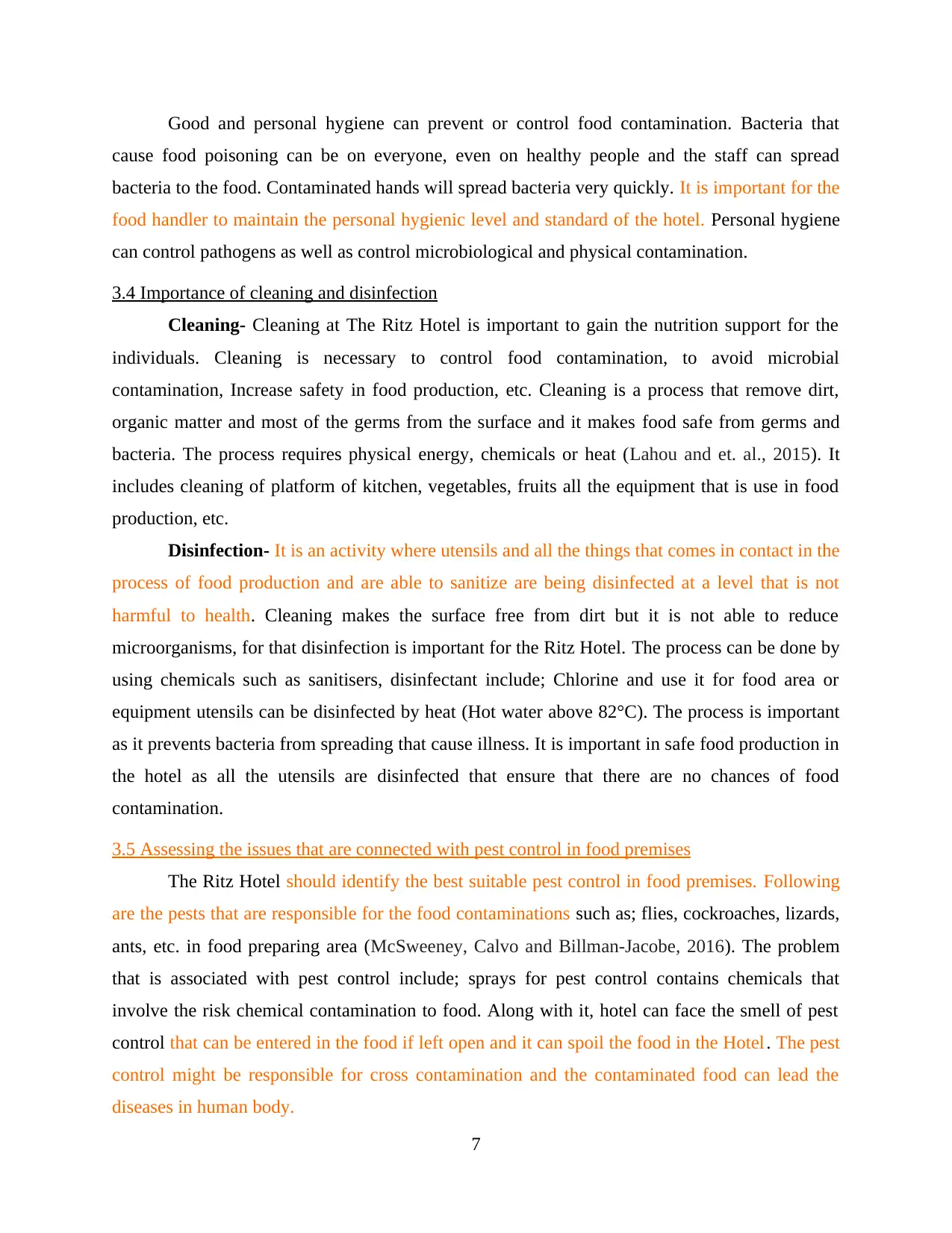
Good and personal hygiene can prevent or control food contamination. Bacteria that
cause food poisoning can be on everyone, even on healthy people and the staff can spread
bacteria to the food. Contaminated hands will spread bacteria very quickly. It is important for the
food handler to maintain the personal hygienic level and standard of the hotel. Personal hygiene
can control pathogens as well as control microbiological and physical contamination.
3.4 Importance of cleaning and disinfection
Cleaning- Cleaning at The Ritz Hotel is important to gain the nutrition support for the
individuals. Cleaning is necessary to control food contamination, to avoid microbial
contamination, Increase safety in food production, etc. Cleaning is a process that remove dirt,
organic matter and most of the germs from the surface and it makes food safe from germs and
bacteria. The process requires physical energy, chemicals or heat (Lahou and et. al., 2015). It
includes cleaning of platform of kitchen, vegetables, fruits all the equipment that is use in food
production, etc.
Disinfection- It is an activity where utensils and all the things that comes in contact in the
process of food production and are able to sanitize are being disinfected at a level that is not
harmful to health. Cleaning makes the surface free from dirt but it is not able to reduce
microorganisms, for that disinfection is important for the Ritz Hotel. The process can be done by
using chemicals such as sanitisers, disinfectant include; Chlorine and use it for food area or
equipment utensils can be disinfected by heat (Hot water above 82°C). The process is important
as it prevents bacteria from spreading that cause illness. It is important in safe food production in
the hotel as all the utensils are disinfected that ensure that there are no chances of food
contamination.
3.5 Assessing the issues that are connected with pest control in food premises
The Ritz Hotel should identify the best suitable pest control in food premises. Following
are the pests that are responsible for the food contaminations such as; flies, cockroaches, lizards,
ants, etc. in food preparing area (McSweeney, Calvo and Billman-Jacobe, 2016). The problem
that is associated with pest control include; sprays for pest control contains chemicals that
involve the risk chemical contamination to food. Along with it, hotel can face the smell of pest
control that can be entered in the food if left open and it can spoil the food in the Hotel . The pest
control might be responsible for cross contamination and the contaminated food can lead the
diseases in human body.
7
cause food poisoning can be on everyone, even on healthy people and the staff can spread
bacteria to the food. Contaminated hands will spread bacteria very quickly. It is important for the
food handler to maintain the personal hygienic level and standard of the hotel. Personal hygiene
can control pathogens as well as control microbiological and physical contamination.
3.4 Importance of cleaning and disinfection
Cleaning- Cleaning at The Ritz Hotel is important to gain the nutrition support for the
individuals. Cleaning is necessary to control food contamination, to avoid microbial
contamination, Increase safety in food production, etc. Cleaning is a process that remove dirt,
organic matter and most of the germs from the surface and it makes food safe from germs and
bacteria. The process requires physical energy, chemicals or heat (Lahou and et. al., 2015). It
includes cleaning of platform of kitchen, vegetables, fruits all the equipment that is use in food
production, etc.
Disinfection- It is an activity where utensils and all the things that comes in contact in the
process of food production and are able to sanitize are being disinfected at a level that is not
harmful to health. Cleaning makes the surface free from dirt but it is not able to reduce
microorganisms, for that disinfection is important for the Ritz Hotel. The process can be done by
using chemicals such as sanitisers, disinfectant include; Chlorine and use it for food area or
equipment utensils can be disinfected by heat (Hot water above 82°C). The process is important
as it prevents bacteria from spreading that cause illness. It is important in safe food production in
the hotel as all the utensils are disinfected that ensure that there are no chances of food
contamination.
3.5 Assessing the issues that are connected with pest control in food premises
The Ritz Hotel should identify the best suitable pest control in food premises. Following
are the pests that are responsible for the food contaminations such as; flies, cockroaches, lizards,
ants, etc. in food preparing area (McSweeney, Calvo and Billman-Jacobe, 2016). The problem
that is associated with pest control include; sprays for pest control contains chemicals that
involve the risk chemical contamination to food. Along with it, hotel can face the smell of pest
control that can be entered in the food if left open and it can spoil the food in the Hotel . The pest
control might be responsible for cross contamination and the contaminated food can lead the
diseases in human body.
7
⊘ This is a preview!⊘
Do you want full access?
Subscribe today to unlock all pages.

Trusted by 1+ million students worldwide
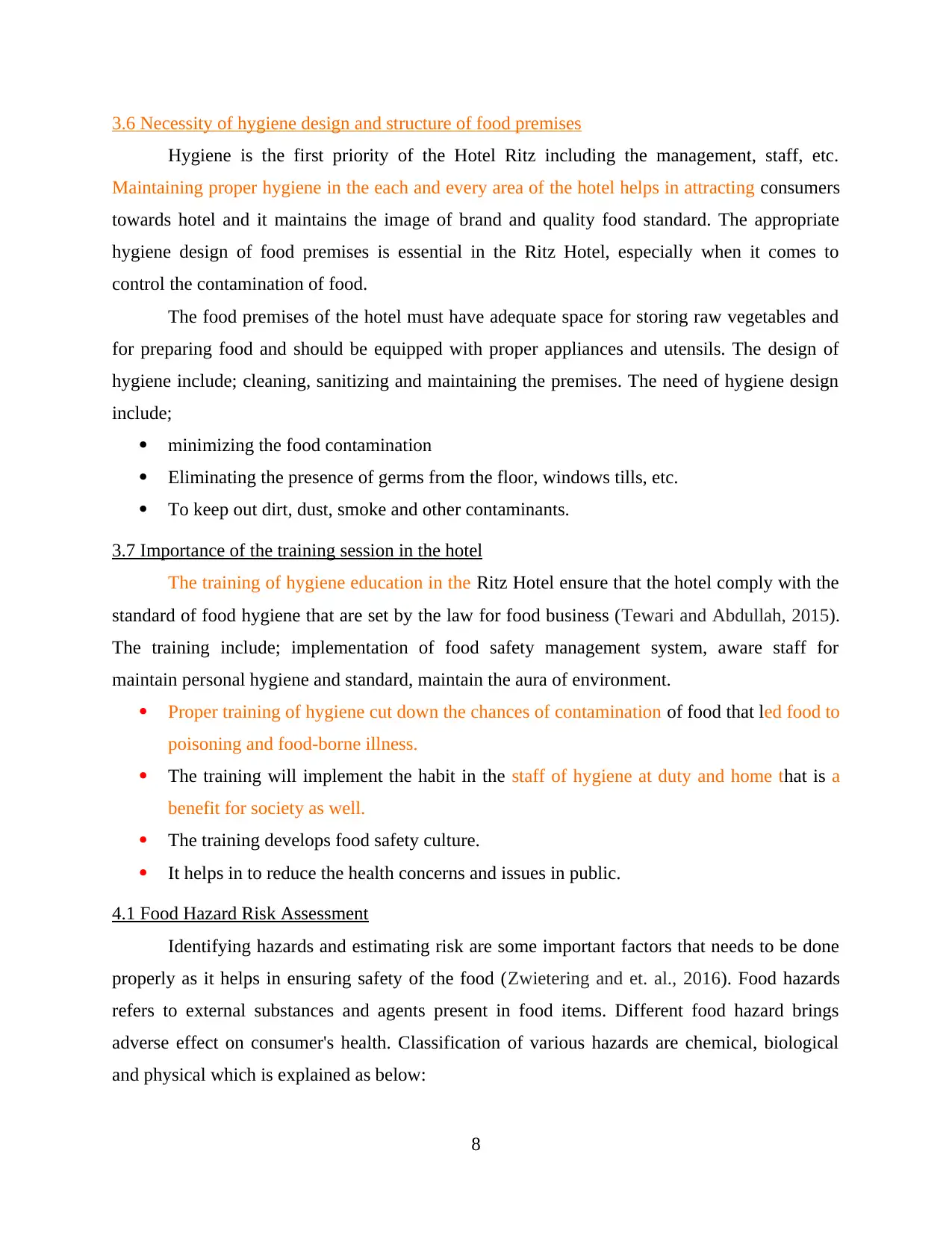
3.6 Necessity of hygiene design and structure of food premises
Hygiene is the first priority of the Hotel Ritz including the management, staff, etc.
Maintaining proper hygiene in the each and every area of the hotel helps in attracting consumers
towards hotel and it maintains the image of brand and quality food standard. The appropriate
hygiene design of food premises is essential in the Ritz Hotel, especially when it comes to
control the contamination of food.
The food premises of the hotel must have adequate space for storing raw vegetables and
for preparing food and should be equipped with proper appliances and utensils. The design of
hygiene include; cleaning, sanitizing and maintaining the premises. The need of hygiene design
include;
minimizing the food contamination
Eliminating the presence of germs from the floor, windows tills, etc.
To keep out dirt, dust, smoke and other contaminants.
3.7 Importance of the training session in the hotel
The training of hygiene education in the Ritz Hotel ensure that the hotel comply with the
standard of food hygiene that are set by the law for food business (Tewari and Abdullah, 2015).
The training include; implementation of food safety management system, aware staff for
maintain personal hygiene and standard, maintain the aura of environment.
Proper training of hygiene cut down the chances of contamination of food that led food to
poisoning and food-borne illness.
The training will implement the habit in the staff of hygiene at duty and home that is a
benefit for society as well.
The training develops food safety culture.
It helps in to reduce the health concerns and issues in public.
4.1 Food Hazard Risk Assessment
Identifying hazards and estimating risk are some important factors that needs to be done
properly as it helps in ensuring safety of the food (Zwietering and et. al., 2016). Food hazards
refers to external substances and agents present in food items. Different food hazard brings
adverse effect on consumer's health. Classification of various hazards are chemical, biological
and physical which is explained as below:
8
Hygiene is the first priority of the Hotel Ritz including the management, staff, etc.
Maintaining proper hygiene in the each and every area of the hotel helps in attracting consumers
towards hotel and it maintains the image of brand and quality food standard. The appropriate
hygiene design of food premises is essential in the Ritz Hotel, especially when it comes to
control the contamination of food.
The food premises of the hotel must have adequate space for storing raw vegetables and
for preparing food and should be equipped with proper appliances and utensils. The design of
hygiene include; cleaning, sanitizing and maintaining the premises. The need of hygiene design
include;
minimizing the food contamination
Eliminating the presence of germs from the floor, windows tills, etc.
To keep out dirt, dust, smoke and other contaminants.
3.7 Importance of the training session in the hotel
The training of hygiene education in the Ritz Hotel ensure that the hotel comply with the
standard of food hygiene that are set by the law for food business (Tewari and Abdullah, 2015).
The training include; implementation of food safety management system, aware staff for
maintain personal hygiene and standard, maintain the aura of environment.
Proper training of hygiene cut down the chances of contamination of food that led food to
poisoning and food-borne illness.
The training will implement the habit in the staff of hygiene at duty and home that is a
benefit for society as well.
The training develops food safety culture.
It helps in to reduce the health concerns and issues in public.
4.1 Food Hazard Risk Assessment
Identifying hazards and estimating risk are some important factors that needs to be done
properly as it helps in ensuring safety of the food (Zwietering and et. al., 2016). Food hazards
refers to external substances and agents present in food items. Different food hazard brings
adverse effect on consumer's health. Classification of various hazards are chemical, biological
and physical which is explained as below:
8
Paraphrase This Document
Need a fresh take? Get an instant paraphrase of this document with our AI Paraphraser
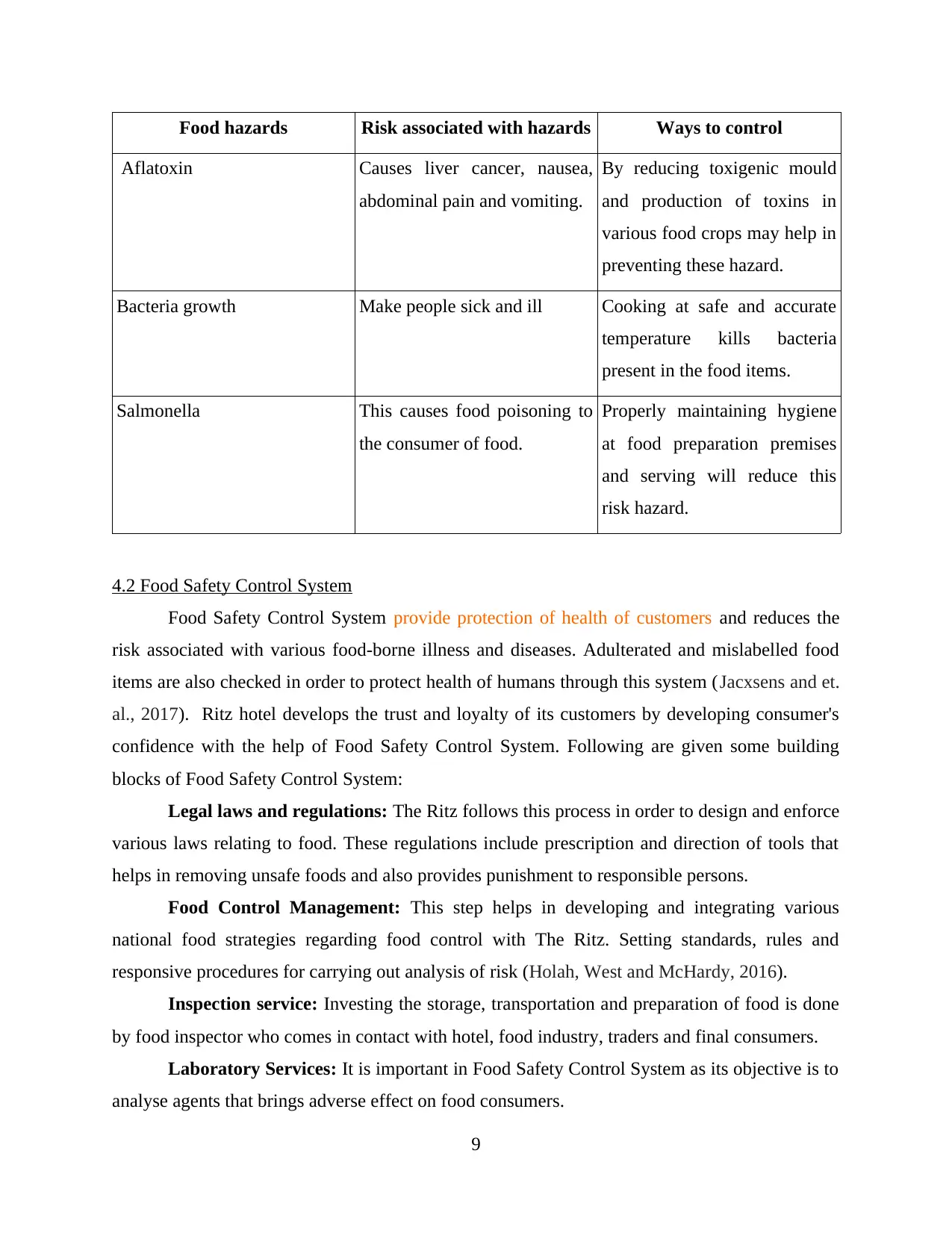
Food hazards Risk associated with hazards Ways to control
Aflatoxin Causes liver cancer, nausea,
abdominal pain and vomiting.
By reducing toxigenic mould
and production of toxins in
various food crops may help in
preventing these hazard.
Bacteria growth Make people sick and ill Cooking at safe and accurate
temperature kills bacteria
present in the food items.
Salmonella This causes food poisoning to
the consumer of food.
Properly maintaining hygiene
at food preparation premises
and serving will reduce this
risk hazard.
4.2 Food Safety Control System
Food Safety Control System provide protection of health of customers and reduces the
risk associated with various food-borne illness and diseases. Adulterated and mislabelled food
items are also checked in order to protect health of humans through this system (Jacxsens and et.
al., 2017). Ritz hotel develops the trust and loyalty of its customers by developing consumer's
confidence with the help of Food Safety Control System. Following are given some building
blocks of Food Safety Control System:
Legal laws and regulations: The Ritz follows this process in order to design and enforce
various laws relating to food. These regulations include prescription and direction of tools that
helps in removing unsafe foods and also provides punishment to responsible persons.
Food Control Management: This step helps in developing and integrating various
national food strategies regarding food control with The Ritz. Setting standards, rules and
responsive procedures for carrying out analysis of risk (Holah, West and McHardy, 2016).
Inspection service: Investing the storage, transportation and preparation of food is done
by food inspector who comes in contact with hotel, food industry, traders and final consumers.
Laboratory Services: It is important in Food Safety Control System as its objective is to
analyse agents that brings adverse effect on food consumers.
9
Aflatoxin Causes liver cancer, nausea,
abdominal pain and vomiting.
By reducing toxigenic mould
and production of toxins in
various food crops may help in
preventing these hazard.
Bacteria growth Make people sick and ill Cooking at safe and accurate
temperature kills bacteria
present in the food items.
Salmonella This causes food poisoning to
the consumer of food.
Properly maintaining hygiene
at food preparation premises
and serving will reduce this
risk hazard.
4.2 Food Safety Control System
Food Safety Control System provide protection of health of customers and reduces the
risk associated with various food-borne illness and diseases. Adulterated and mislabelled food
items are also checked in order to protect health of humans through this system (Jacxsens and et.
al., 2017). Ritz hotel develops the trust and loyalty of its customers by developing consumer's
confidence with the help of Food Safety Control System. Following are given some building
blocks of Food Safety Control System:
Legal laws and regulations: The Ritz follows this process in order to design and enforce
various laws relating to food. These regulations include prescription and direction of tools that
helps in removing unsafe foods and also provides punishment to responsible persons.
Food Control Management: This step helps in developing and integrating various
national food strategies regarding food control with The Ritz. Setting standards, rules and
responsive procedures for carrying out analysis of risk (Holah, West and McHardy, 2016).
Inspection service: Investing the storage, transportation and preparation of food is done
by food inspector who comes in contact with hotel, food industry, traders and final consumers.
Laboratory Services: It is important in Food Safety Control System as its objective is to
analyse agents that brings adverse effect on food consumers.
9
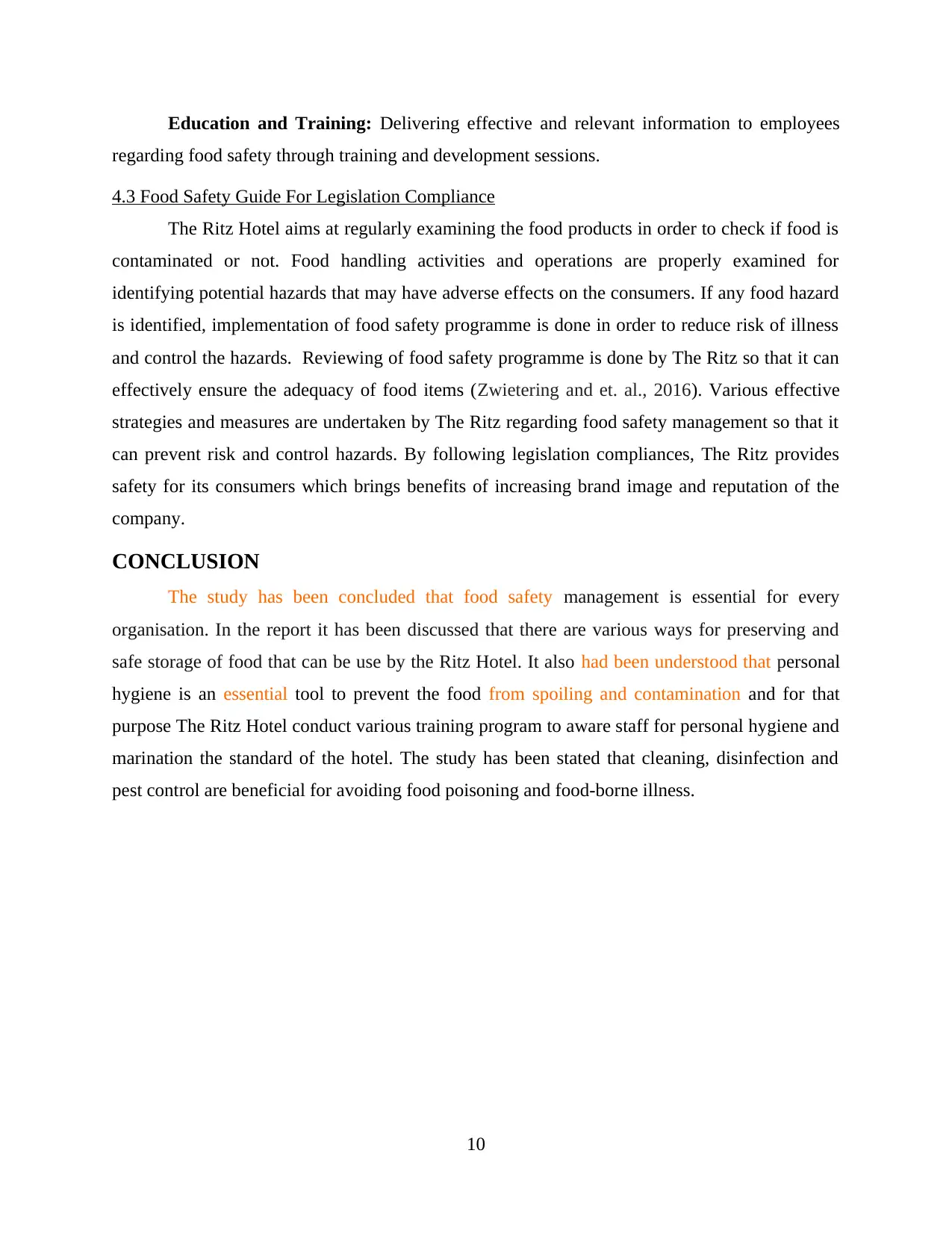
Education and Training: Delivering effective and relevant information to employees
regarding food safety through training and development sessions.
4.3 Food Safety Guide For Legislation Compliance
The Ritz Hotel aims at regularly examining the food products in order to check if food is
contaminated or not. Food handling activities and operations are properly examined for
identifying potential hazards that may have adverse effects on the consumers. If any food hazard
is identified, implementation of food safety programme is done in order to reduce risk of illness
and control the hazards. Reviewing of food safety programme is done by The Ritz so that it can
effectively ensure the adequacy of food items (Zwietering and et. al., 2016). Various effective
strategies and measures are undertaken by The Ritz regarding food safety management so that it
can prevent risk and control hazards. By following legislation compliances, The Ritz provides
safety for its consumers which brings benefits of increasing brand image and reputation of the
company.
CONCLUSION
The study has been concluded that food safety management is essential for every
organisation. In the report it has been discussed that there are various ways for preserving and
safe storage of food that can be use by the Ritz Hotel. It also had been understood that personal
hygiene is an essential tool to prevent the food from spoiling and contamination and for that
purpose The Ritz Hotel conduct various training program to aware staff for personal hygiene and
marination the standard of the hotel. The study has been stated that cleaning, disinfection and
pest control are beneficial for avoiding food poisoning and food-borne illness.
10
regarding food safety through training and development sessions.
4.3 Food Safety Guide For Legislation Compliance
The Ritz Hotel aims at regularly examining the food products in order to check if food is
contaminated or not. Food handling activities and operations are properly examined for
identifying potential hazards that may have adverse effects on the consumers. If any food hazard
is identified, implementation of food safety programme is done in order to reduce risk of illness
and control the hazards. Reviewing of food safety programme is done by The Ritz so that it can
effectively ensure the adequacy of food items (Zwietering and et. al., 2016). Various effective
strategies and measures are undertaken by The Ritz regarding food safety management so that it
can prevent risk and control hazards. By following legislation compliances, The Ritz provides
safety for its consumers which brings benefits of increasing brand image and reputation of the
company.
CONCLUSION
The study has been concluded that food safety management is essential for every
organisation. In the report it has been discussed that there are various ways for preserving and
safe storage of food that can be use by the Ritz Hotel. It also had been understood that personal
hygiene is an essential tool to prevent the food from spoiling and contamination and for that
purpose The Ritz Hotel conduct various training program to aware staff for personal hygiene and
marination the standard of the hotel. The study has been stated that cleaning, disinfection and
pest control are beneficial for avoiding food poisoning and food-borne illness.
10
⊘ This is a preview!⊘
Do you want full access?
Subscribe today to unlock all pages.

Trusted by 1+ million students worldwide
1 out of 14
Related Documents
Your All-in-One AI-Powered Toolkit for Academic Success.
+13062052269
info@desklib.com
Available 24*7 on WhatsApp / Email
![[object Object]](/_next/static/media/star-bottom.7253800d.svg)
Unlock your academic potential
Copyright © 2020–2025 A2Z Services. All Rights Reserved. Developed and managed by ZUCOL.





